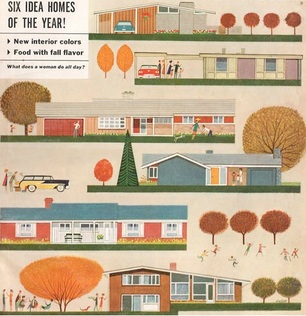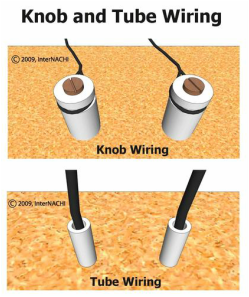Are you considering purchasing an older home? Maybe you have plans of restoring it to its former glory. There are some things to be aware of when deciding to move forward with the purchase of an older home. When Bennett Property Inspection inspects an older home, for example a home built in the 1950’s we are doing this inspection in the context of the time period in which it was built, but balancing it against contemporary, acceptable building practices, and the general quality of the home.
Experience counts for a lot in evaluating older structures when you’re less familiar with the building practices and codes used for building the home. If your inspector has looked at many older homes, then they will have a much better your understanding of what was considered acceptable at the time the home was built.
The laws of physics haven’t changed with time, however, so many things that make a building safe or unsafe haven’t changed either. Older buildings, especially those that have been poorly maintained, present good opportunities to study the failures and successes of the various home materials and systems.
The elements that cause the deterioration of different home components have had longer to work on older homes. We use keen eyes and pay special attention at parts of the home that are exposed to the elements, such as the foundation, wall coverings and roof.
Foundation
The foundation is probably the main priority, since it’s the component that bears the load of the entire home. Foundation failure or repairs can be especially expensive, and parts of it may be hidden.
Wall Coverings
The wall coverings often provide clues to any foundation movement. Soil or foundation movement typically shows up as diagonal cracks emanating from the corners of doors and windows. You may also see stepped cracking in masonry walls, especially near exterior corners or below windows.
Roof
The roofs of older homes in our area are typically shingles or tile. Often, the roof of an older home will need replacement soon, the owner or potential buyer may be facing not just removal of existing layers, but installation of solid roof sheathing over the original dimensional sheathing that was typically installed with older roofs in our area.
Structure
Older homes may have undergone work by someone not familiar with acceptable building practices. Although it’s often difficult to see floor and wall framing, we look for problems such as the structure being out of plumb, out of level, or not flat.
The work done may also have employed methods quite different from modern methods, so just because it looks different there maybe nothing wrong with it. It might just be a reflection of the era it was built in. We will look for theses types of issues and if they pose a concern.
Exterior
When lead was used as an ingredient in the manufacture of paint, the exterior paint coating would eventually oxidize, and a lead powder would form on the surface, ultimately washing into the soil around the home's exterior by the rain. Over time, lead can accumulate in the soil to a level at which it represents a health risk to children and pets. A lead test of the soil of the home's perimeter can be performed if its a concern of the potential buyer.
Windows
It’s often difficult to tell whether a window is original, and it’s a question that’s often asked. At Bennett Property Inspection, its our job to describe the window's condition. We look for failure of the finish coating and decay on wood-frame windows, especially in the corners of the sill. You’ll be checking for hardware condition, and proper operation of the hardware and window itself. Single panes are not a defect.
Electrical Systems
In inspecting an older home, we may find that the electrical system is original, that it’s new, or that it has had work done on it over the years. It’s not unusual to find electrical components from multiple eras in one home. They may all be energized, or they may be partially energized.
When we are confronted with these older systems, we recommend a specialist inspection by a qualified electrical contractor. The liability connected with electrical systems is high, since these can burn down the home or cause serious or fatal injury.
Plumbing Systems
There are still a few homes around with galvanized supply pipes, so we will check for functional flow at fixtures. Also, we will alert you to any unsafe conditions, such as missing or obsolete traps. In the past, lead distribution pipes have been a problem, but very few currently exist any longer.
Heating Systems
Serious problems can develop from poorly understood venting of furnaces and water heaters. Condensation is one problem. Water is a solvent and will deteriorate many materials.
Where heating equipment has been vented through older brick chimneys, we will look for damage to the brick at the exterior, at the interior, and to the lining. We will also be checking for proper cleanouts, and if the chimney has a lining.
Toxic Materials
Sometimes we encounter toxic materials when inspecting older homes. Asbestos-like material on heating system exhaust ducts is something we most certainly look for and alert the client to. Asbestos was also used in vinyl products, such as flooring, and in the process of manufacturing roofing tiles. The amount of asbestos in thermal insulation has been exaggerated, but most thermal insulation releases particulates into the air when it’s disturbed, so you should wear a respirator in attics and crawlspaces where you may encounter exposure.
For questions concerning property inspections, or to schedule your property inspection, contact Bennett Property Inspection today at (813) 260-9920.
Experience counts for a lot in evaluating older structures when you’re less familiar with the building practices and codes used for building the home. If your inspector has looked at many older homes, then they will have a much better your understanding of what was considered acceptable at the time the home was built.
The laws of physics haven’t changed with time, however, so many things that make a building safe or unsafe haven’t changed either. Older buildings, especially those that have been poorly maintained, present good opportunities to study the failures and successes of the various home materials and systems.
The elements that cause the deterioration of different home components have had longer to work on older homes. We use keen eyes and pay special attention at parts of the home that are exposed to the elements, such as the foundation, wall coverings and roof.
Foundation
The foundation is probably the main priority, since it’s the component that bears the load of the entire home. Foundation failure or repairs can be especially expensive, and parts of it may be hidden.
Wall Coverings
The wall coverings often provide clues to any foundation movement. Soil or foundation movement typically shows up as diagonal cracks emanating from the corners of doors and windows. You may also see stepped cracking in masonry walls, especially near exterior corners or below windows.
Roof
The roofs of older homes in our area are typically shingles or tile. Often, the roof of an older home will need replacement soon, the owner or potential buyer may be facing not just removal of existing layers, but installation of solid roof sheathing over the original dimensional sheathing that was typically installed with older roofs in our area.
Structure
Older homes may have undergone work by someone not familiar with acceptable building practices. Although it’s often difficult to see floor and wall framing, we look for problems such as the structure being out of plumb, out of level, or not flat.
The work done may also have employed methods quite different from modern methods, so just because it looks different there maybe nothing wrong with it. It might just be a reflection of the era it was built in. We will look for theses types of issues and if they pose a concern.
Exterior
When lead was used as an ingredient in the manufacture of paint, the exterior paint coating would eventually oxidize, and a lead powder would form on the surface, ultimately washing into the soil around the home's exterior by the rain. Over time, lead can accumulate in the soil to a level at which it represents a health risk to children and pets. A lead test of the soil of the home's perimeter can be performed if its a concern of the potential buyer.
Windows
It’s often difficult to tell whether a window is original, and it’s a question that’s often asked. At Bennett Property Inspection, its our job to describe the window's condition. We look for failure of the finish coating and decay on wood-frame windows, especially in the corners of the sill. You’ll be checking for hardware condition, and proper operation of the hardware and window itself. Single panes are not a defect.
Electrical Systems
In inspecting an older home, we may find that the electrical system is original, that it’s new, or that it has had work done on it over the years. It’s not unusual to find electrical components from multiple eras in one home. They may all be energized, or they may be partially energized.
When we are confronted with these older systems, we recommend a specialist inspection by a qualified electrical contractor. The liability connected with electrical systems is high, since these can burn down the home or cause serious or fatal injury.
Plumbing Systems
There are still a few homes around with galvanized supply pipes, so we will check for functional flow at fixtures. Also, we will alert you to any unsafe conditions, such as missing or obsolete traps. In the past, lead distribution pipes have been a problem, but very few currently exist any longer.
Heating Systems
Serious problems can develop from poorly understood venting of furnaces and water heaters. Condensation is one problem. Water is a solvent and will deteriorate many materials.
Where heating equipment has been vented through older brick chimneys, we will look for damage to the brick at the exterior, at the interior, and to the lining. We will also be checking for proper cleanouts, and if the chimney has a lining.
Toxic Materials
Sometimes we encounter toxic materials when inspecting older homes. Asbestos-like material on heating system exhaust ducts is something we most certainly look for and alert the client to. Asbestos was also used in vinyl products, such as flooring, and in the process of manufacturing roofing tiles. The amount of asbestos in thermal insulation has been exaggerated, but most thermal insulation releases particulates into the air when it’s disturbed, so you should wear a respirator in attics and crawlspaces where you may encounter exposure.
For questions concerning property inspections, or to schedule your property inspection, contact Bennett Property Inspection today at (813) 260-9920.



 RSS Feed
RSS Feed

